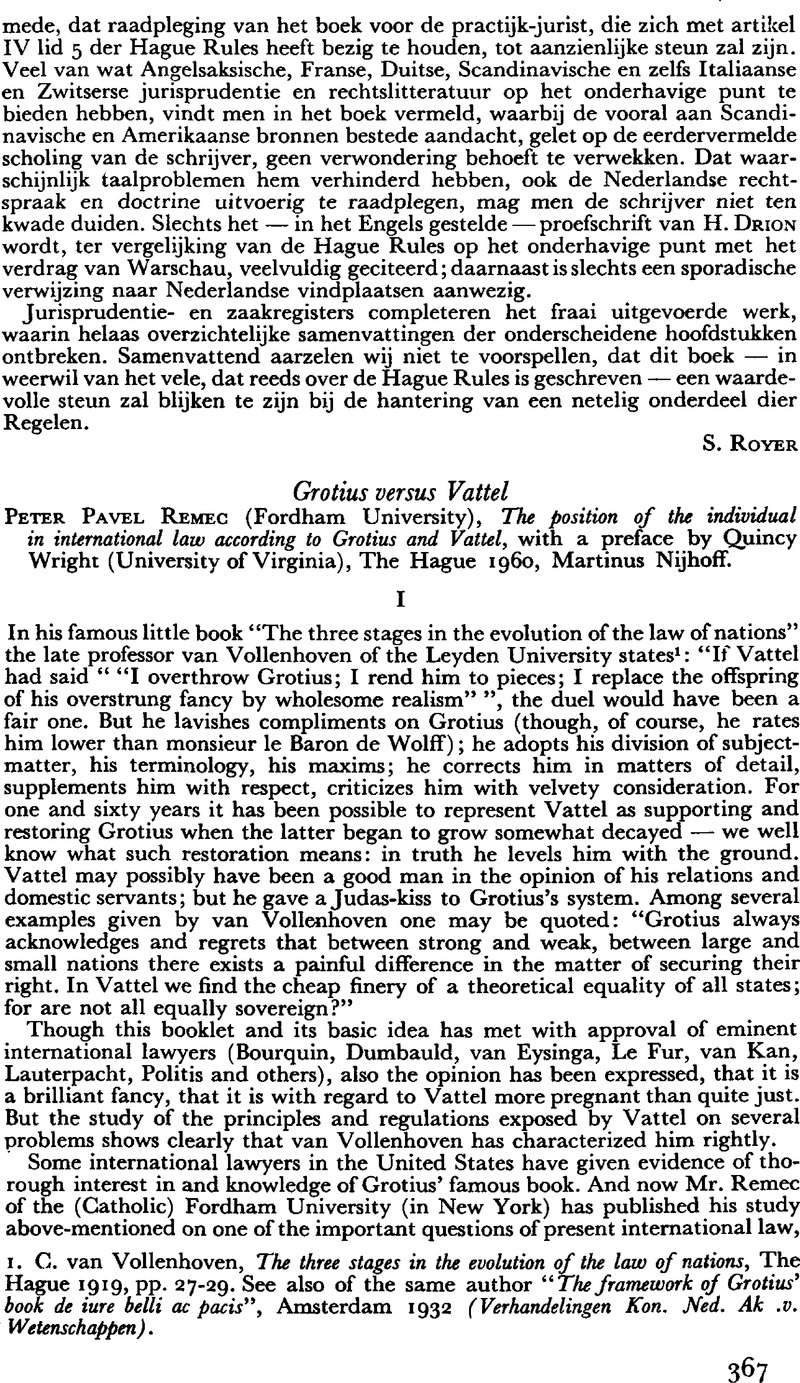No CrossRef data available.
Article contents
Grotius versus Vattel - Peter Pavel Remec (Fordham University), The position of the individual in international law according to Grotius and Vattel, with a preface by Quincy Wright (University of Virginia), The Hague1960, Martinus Nijhoff.
Published online by Cambridge University Press: 21 May 2009
Abstract

- Type
- Boekbesprekingen—Book Reviews
- Information
- Copyright
- Copyright © T.M.C. Asser Press 1961
References
page 367 note 1. van Vollenhoven, C., The three stages in the evolution of the law of nations, The Hague 1919, pp. 27–29.Google Scholar See also of the same author “The framework of Grotius' book de iure belli ac pacis”, Amsterdam 1932Google Scholar (Verhandelingen Kon. Ned. Ak. v. Wetenschappen).
page 368 note 1. p. 57.
page 368 note 2. See Remec, , pp. 3, 40, 41.Google Scholar He gives an excellent exposition of the developmens of this problem in the present century, such in close relation to earlier writerr. The space available does not permit to enter here into this important mattet. Fortuin, Confer H., De natuurrechtelijke grondslagen van de Groot's volkenrecht (The principles of natural law in Grotius' De iure belli ac pacts), The Hague 1946, pp. 199–203.Google Scholar
page 368 note 3. Remec, , pp. 46–47.Google Scholar See also Fortuin, o.c., chapters III and IX.
page 369 note 1. Remec, , pp. 49, 50, 51, 53, 54, 63Google Scholar and confer p. 58 note 1. Cf. van Vollenhoven, C., Grotius and Geneva, Bibliotheca Visseriana, Tomus sextus, Leyden 1926, pp. 1–81, particularly pp. 19 and 20.Google Scholar
page 369 note 2. Grotius, , De iure belli ac pacts, III, 19, 2, ed. Molhuysen, Leyden 1919, p. 643.Google Scholar
page 369 note 3. The framework, pp. 140–155, 130, 136Google Scholar; cf. Remec, , p. 236.Google Scholar
page 369 note 4. Remec, , pp. 59, 61, 63, 69, 114, 124Google Scholar; cf. Politis, N., La neutralité et la paix, Paris 1935, p. 19.Google Scholar
page 369 note 5. de Vattel, Emer, Le droit des gens, ou principes de la loi naturelle, appliqués à la conduite et aux affaires des nations et des souverainsGoogle Scholar, The Classics of International Law no. 4.
page 370 note 1. Cf. the excellent study of the late SirLauterpacht, Hersch, The Grotian tradition in international law, par. 5Google Scholar, in: The British Yearbook of International Law 1946, pp. 30 f.Google Scholar Grotius wrote to his brother, April 11, 1643: “Librum de Cive vidi, placent quae pro Regibus dicit. Fundamenta tamen quibus suas sententias superstruit, probare non possum. Putat inter homines omnes a natura esse bellum et [die] quaedam habet nostris non congruentia”, Epistolae quotquot reperiri potuerunt, Amstelodami MDCLXXXVII, no. 648, pp. 951–952.Google Scholar
page 370 note 2. Remec, , pp. 217, 219, 220, 221, 225.Google Scholar
page 370 note 3. Remec, , pp. 228, 229, 234.Google Scholar
page 370 note 4. Remec, , pp. 236, 239, 243.Google Scholar
page 370 note 5. See e.g. Maurice Bourquin, Grotius et les tendances actuelles du droit international, in Revue de droit international et de législation comparée, 1926, pp. 86–125Google Scholar, especially pp. 94 and 96; Edward Dumbauld, Hugo Grotius: The father of international law, in Journal of Public Law, Emory University 1952, pp. 117–137Google Scholar, especially pp. 118–119; Jhr. van Eysinga, W. J. M., Essai d'une esquisse de la structure juridique du monde actuel, Amsterdam 1961Google Scholar; Sir Hersch Lauterpacht, The Grotian tradition in international law, already quoted and mentionedby R.; van Vollenhoven, C., The three stages in the evolution of the law of nationsGoogle Scholar, already quoted and mentioned by R.; van Vollenhoven, The framework of Grotius' book de iure belli ac pacis, already quoted; van Vollenhoven, Grotius and Geneva, already quoted. See also van Eysinga, , Gids voor de Groots De iure belli ac pacis, Leyden 1945Google Scholar; Fortuin, H., De natuurrechtelijke grondslagen van de Groat's volkenrechtGoogle Scholar, already quoted, especially chapters XII and XIII.
page 371 note 1. Remec, , pp. 131, 132, 134, 137, 143, 145.Google Scholar
page 371 note 2. Remec, , pp. 171, 180, 181, 182.Google Scholar
page 371 note 3. See Vattel, , o.c., Introduction, par. 16, pp. 6 f.Google Scholar
page 371 note 4. See Vattel, , o.c., II, 2, 16, p. 188 note (a).Google Scholar
page 371 note 5. Remec, , pp. 183, 185, 193, 198.Google Scholar
page 371 note 6. See Grotius, , o.c., I, 4, 1:3, p. 104Google Scholar: Deo magis quam hominibus obediendum.
page 372 note 1. On quite another part of the comprehensive field of Grotius' works an extremely interesting inaugural speech of C. van der Woude has lately been published, held before the theological University at Kampen and entitled: “Hugo Grotius en zijn (and his) Pietas Ordinum Hollandlae ac Westfrisiae vindicata”. In this speech the author, giving evidence of his extensive knowledge and of his erudition, explains the contra-remonstrant view as to this notorious pamphlet of Grotius.


